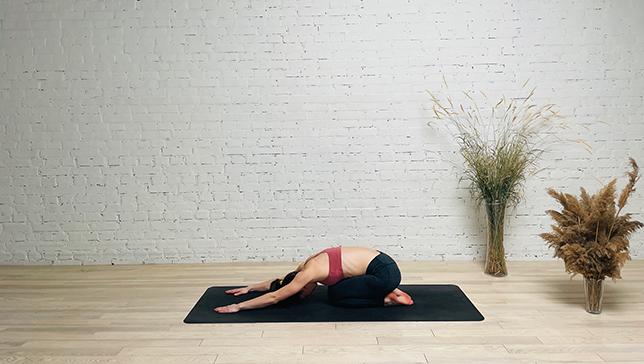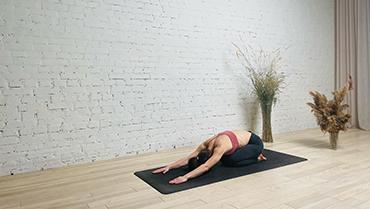Extended Child Pose - Utthita Balasana

Contents
Extended Child Pose, also known as Utthita Balasana (oo-tee-tah – bal-AHS-anna), is a gentle and rejuvenating posture that brings a sense of calmness to both the body and mind. The name of this pose originates from Sanskrit, with “utthita” meaning “extended,” “bala” meaning “child,” and “asana” meaning “pose.”
Utthita Balasana serves as a wonderful opportunity to establish a deeper connection with your breath, consciously directing it towards the back of the body and lungs. With each inhalation, the back of the body gently expands, while each exhalation encourages a lengthening of the torso and spine.
This posture offers a soothing and cooling effect, making it particularly beneficial for finding balance and restoring harmony after a challenging asana practice or as a restorative pose. You may choose to direct your gaze downward or inward, promoting introspection during this forward bending posture.
Utthita Balasana is believed to have a calming influence on the muladhara chakra, aiding in grounding the energy in the pelvic region. Furthermore, due to the lowered position of the head, it is said to pacify the vata energy within the body.
Pose Detail
- Difficulty: Beginners
- By Type: Flexibility Yoga Poses, Strengthening Yoga Poses
- Body Position: Forward Bend Yoga Poses, Seated Yoga Poses
- By Benefit: Yoga Poses For Digestion, Yoga Poses For Stress Relief
Step-by-Step Instructions
Benefits and Contraindications
Stretches the entire length of the spine, including the neck and shoulders, helping to relieve stiffness and improve posture
Stimulate digestion and help relieve bloating
Relieves stress and tension
Improves flexibility
Soothes the nervous system
Knee injuries
High blood pressure
Pregnancy after the first trimester
Diarrhea
Ankle injuries
Photo poses in different angles

Modifications and Props for Beginners
- If you have knee pain or discomfort, you can place a folded blanket or cushion between your thighs and calves, or you can widen your knees slightly to reduce the pressure on your knees.
- You can place a bolster or cushion under your chest, arms, or forehead to provide support and make the pose more comfortable.
- If you have shoulder or neck pain, you can place your arms alongside your body, with your palms facing up or down, instead of reaching them forward.
- You can place a block or two under your forehead to elevate it and provide support for your neck.
- If you have limited flexibility in your shoulders or arms, you can use a strap to help you reach forward and lengthen your spine.
Useful Tips
- As you hold the pose, focus on your breath and try to deepen your inhalations and exhalations, which can help you relax and release tension in your body.
- Remember to listen to your body and only go as far as you feel comfortable in the pose. With practice, you may be able to deepen the stretch and hold the pose for longer periods.
Frequently Asked Questions
Yes, Extended Child Pose is a gentle yoga pose that is suitable for beginners. It can also be modified by placing a block or bolster under the forehead or chest for added support.
You can hold Extended Child Pose for 5-10 breaths, or longer if it feels comfortable.
Yes, Extended Child Pose can be modified for pregnancy by placing a blanket or pillow under the hips for added support and avoiding any deep stretching of the belly.
If you feel discomfort or pain in Extended Child Pose, come out of the pose slowly and gently. You can modify the pose or skip it altogether if it doesn’t feel comfortable for your body.
Variations
- Child Pose
- Extended Puppy Pose
- Thread The Needle Pose
- Supported Child Pose